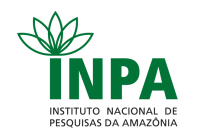Corpo Discente - Egressos
Moisés Santos de Souza
| Título | Armadilhas Iscadas para Hypothenemus hampei, (Coleoptera:Scolytinae) em plantações de café conilon na Amazônia Ocidental | ||||||||||||||||||||||||
| Data da Defesa | 04/06/2018 | ||||||||||||||||||||||||
| Download | Em sigilo | ||||||||||||||||||||||||
Banca
| |||||||||||||||||||||||||
| Palavras-Chaves | Broca-do-café;atrativos;armadilhas iscadas;controle populacional | ||||||||||||||||||||||||
| Resumo | O Hypothenemus hampei (Ferrari, 1867) (Coleoptera: Scolytidae), é a mais importante praga das lavouras cafeeiras em todo o mundo e causa grandes prejuízos para os agricultores. Compreender o comportamento dessa praga e sua resposta para atrativos sintéticos é essencial para o desenvolvimento de estratégias para o seu manejo integrado. Por isso, objetivou-se avaliar armadilhas iscadas em campo como ferramenta para testes de potenciais atrativos e modo de instalação para monitoramento e controle da broca-do-café, H. hampei. O estudo teve início em abril de 2015 com avaliação dos potenciais atrativos etileno (ETL); acetato de etila (AE) e combinações desses com os álcoois etanol (ET) e metanol (MT) para a captura de H. hampei em armadilhas iscadas. O experimento foi conduzido em esquema de parcelas subdivididas numa plantação de café Coffea canephora, Conilon. Dos atrativos não usuais, o H. hampei preferiu o AE em relação ao ETL. Não houve efeito sinérgico nas armadilhas iscadas com AE e ETL e os álcoois ET e MT. Maior atratividade foi observada nas armadilhas iscadas apenas com ET e MT. Esse resultado definiu os tratamentos posteriores para continuidade da avaliação de combinações do éster AE com o ET e MT. Utilizando o mesmo delineamento experimental de distribuição das armadilhas da etapa anterior, definiu-se diferentes combinações binárias e ternária na proporção 1:1 entre os álcoois (ET e MT) com AE. Nesta segunda etapa de avaliação (maio a outubro de 2015), confirmou-se que a mistura ET e MT (1:1) é o atrativo mais eficaz para captura dessa praga em relação às diferentes combinações com o AE. Na terceira etapa do estudo (outubro de 2015 a março de 2016) foi utilizado apenas o atrativo mais eficaz e foi observado que alturas mais baixas não maximizaram a captura do H. hampei presentes nos frutos remanescentes do solo. A utilização das armadilhas iscadas durante a entressafra reduziu significativamente a infestação e o broqueamento de frutos, comparado a uma área de controle (sem armadilhas), sugerindo que pode ser uma ferramenta eficiente para o controle populacional do H. hampei. Em linhas gerais, os resultados dessas avaliações tiveram como resultados a versatilidade das armadilhas iscadas como ferramenta adequada para o teste de atrativos para o H. hampei em campo, redução populacional deste inseto e consequentemente dos danos e prejuízos causados por esta espécie. Também a utilidade desta ferramenta para o monitoramento da praga de maneira acurada. | ||||||||||||||||||||||||
| Abstract | Hypothenemus hampei (Ferrari, 1867) (Coleoptera: Scolytidae) is the most significant pests on coffee plantations in the world and causes great damage for farmers. Understanding this pest‟s behavior and its response to synthetic attractants is essential for the development of strategies for its integrated management. Therefore, we aimed to evaluate baited traps in fields as a tool for testing potential attractants and the mode of installation for monitoring and controlling the coffee berry borer, H. hampei. The study began in April 2015 with evaluation of the potential attractants ethylene (ETL); ethyl acetate (EA) and combinations thereof with ethanolic (ET) and methanolic (MT) alcohols for the capture of H. hampei in baited traps. The experiment was conducted in a subdivided plot scheme on a coffee plantation with Coffea canephora, Conilon. Of the unusual attractants, H. hampei preferred EA over ETL. There was no synergistic effect on the baited traps with EA and ETL and ET and MT alcohols. The greatest attractiveness was observed in traps baited with ET and MT alone. This result defined the subsequent treatments for continuing the evaluation of combinations of the ester EA with ET and MT. Using the same experimental design of trap distribution as the previous step, different binary and ternary combinations were defined at a 1:1 ratio between alcohols (ET and MT) with EA. In this second stage of evaluation (May to October 2015), it was confirmed that the mixture of ET and MT (1:1) is the most effective attractant in capturing this pest compared to the different combinations with EA. In the third stage of the study (October 2015 to March 2016) only the most effective attractant was used and it was observed that lower heights did not maximize the capture of H. hampei present in the remaining fruits from the soil. The use of baited traps during the off season significantly reduced fruit infestation and boring, compared to a control area (without traps), suggesting that it may be an efficient tool for population control of H. hampei. In general, the results of these evaluations resulted in the versatility of the baited traps as an adequate tool for the test of attractiveness for H. hampei in the field, population reduction of this insect, and consequently, of damages and losses caused by this species. In addition, the usefulness of this tool for monitoring the pest accurately is shown | ||||||||||||||||||||||||
Parceiros

























